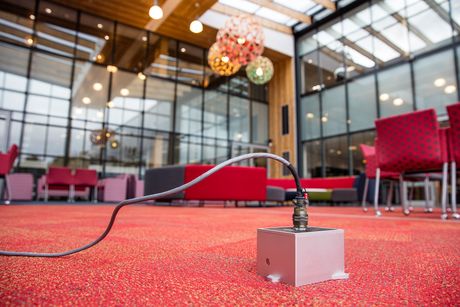Structural safety in a heartbeat

Structural monitoring technology that can pinpoint structural damage and stability issues in real time in order to mitigate risk and enhance safety has been introduced to Australia and New Zealand by Mainmark.
According to US developer Dr Alan Jeary, who was in Sydney this week for the launch, the technology is called STRAAM (which stands for structural risk assessment and management) and it can measure the unique dynamic signature, or the ‘heartbeat’, of any above-ground structure.
It works by using non-destructive ground monitors such as accelerometers to conduct a Structural-Cardiograph (SCG) measuring the vibrations that occur in responses to environment factors. This establishes the building’s dynamic signature and provides real-time reports that accurately assess the stiffness of a structural change in its capacity due to subsidence, ageing, earthquake damage or other activity.
Tim Pope, chief operating officer at Mainmark, said: “Real-time structural analysis can indicate causes of structural damage, likely risk of further damage and overall structural stability.”
Jeary said the product’s patented Random Decrement (RANDEC) damping algorithms are so powerful they can be used to identify where are crack is and even how big it is. “For large structures, results can be achieved within a day or two, and for smaller structures, one to three hours is all that is necessary,” he said. Comprehensive reports, featuring three-dimensional modelling, can then be accessed online.

The product has applications for the construction, property, public infrastructure and insurance industries. “The data can be used to prepare insurance policies and claims, enhance occupant safety, navigate litigation, improve asset management and help to make communities and buildings more resilient to natural disasters,” said Pope.

The equipment is also used to measure vibration intensity levels and can provide in-depth analysis and long-term continuous monitoring. The technology uses full-scale, non-destructive testing and reporting to measure structural integrity for a range of applications and circumstances. For example, it can provide:
- the construction industry with an assessment of dilapidation risk for adjoining properties;
- engineers and architects with an analytically accurate starting point for engineering design;
- building owners and commercial property investors with evidence that an asset is structurally healthy and fit for use;
- insurers with an understanding of inherent risks of insured assets;
- building commissioners with evidence of whether a structure has been built to code and performance specifications;
- dam and bridge asset owners with confidence in the structures’ ongoing integrity and usefulness;
- local councils with information and insights to manage assets more strategically for better return on investment; and
- facility managers with building information to make smarter decisions faster, after structural events or natural disasters.
Mainmark is the exclusive distributor for the STRAAM technologies in Australia and New Zealand.
Heavy machinery injury lands mining company $750K fine
In WA, an underground mining services company has been fined $750,000 after a drill operator...
Timber company fined $385K after conveyor crushing
In Western Australia, a timber company has been fined $385,000 after a worker's arm became...
Alarming commercial driver fatigue, distraction levels: report
A new report by a technology company has revealed some critical data relating to driver fatigue...










